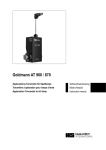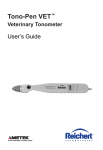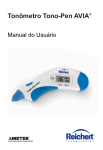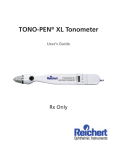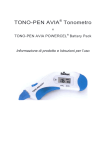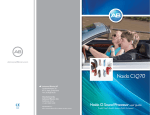Download Reichert TONO-PEN VET User`s guide
Transcript
TONO-PEN AVIA VET™ Veterinary Tonometer User’s Guide The following are registered trademarks of Reichert, Inc. Reichert ® TONO-PEN AVIA VET™ TONO-PEN AVIA VET POWERCEL® OCU-FILM® ©2012 Reichert, Inc. The information contained in this document was accurate at time of publication. Reichert, Inc. reserves the right to make changes in the product described in this manual without notice and without incorporating those changes in any products already sold. ISO 9001/13485 Certified – Reichert products are designed and manufactured under quality processes meeting ISO 9001/13485 requirements. Caution: Federal law restricts this device to sale by or on the order of a licensed physician. Rx Only. 2 230750-101, Rev. C. Table of Contents Introduction 4 Warnings and Cautions 6 General Overview 8 TONO-PEN AVIA VET Tonometer Modes 9 TONO-PEN AVIA VET Verification 10 TONO-PEN AVIA VET Tonometer Tones 11 Battery Pack Installation and Replacement 12 Liquid Crystal Display (User Interface) 13 TONO-PEN AVIA VET Tonometer Preparation 15 Verification Mode 16 Performing IOP Measurements 17 Applanation 18 Interpreting the IOP Measurement 19 Maintenance and Storage 20 Troubleshooting 22 Specifications 23 Guidance & Manufacturer’s Declaration 24 Symbols 27 Customer Service Information 28 Warranty 29 230750-101, Rev. C. 3 Introduction INTENDED USE The TONO-PEN AVIA® VET tonometer is a prescription only device intended for measuring intraocular pressure (IOP) during routine eye examinations or when increased intraocular pressure is suspected by properly trained eyecare professionals such as veterinarians, and veterinary technicians. Note: The TONO-PEN AVIA VET is not approved for use on humans. INDICATIONS FOR USE The indications for use include measuring intraocular pressure (IOP) for suspected glaucoma, or when increased intraocular pressure is suspected. CONTRAINDICATIONS None. DEVICE DESCRIPTION The TONO-PEN AVIA VET tonometer is an ergonomic, handheld tonometer that measures intraocular pressure. The body of the instrument is designed to fit comfortably in the user’s hand, facilitating fast and accurate measurements. The tip of the tonometer contains a sensor that houses a transducer assembly which converts applied force into an electrical signal. The electronics housed in the ergonomic TONO-PEN AVIA VET tonometer body process and analyze the waveforms produced by each applanation of the corneal surface of the eye. These are used to produce an averaged IOP measurement. The measurement is displayed on the Liquid Crystal Displays (LCDs). A replaceable battery compartment houses the TONO-PEN AVIA VET POWERCEL® battery pack, consisting of two Lithium Manganese Dioxide batteries. 4 230750-101, Rev. C. Introduction (continued) This User’s Guide is designed as a training and reference manual for operation, maintenance, and troubleshooting. We recommend that you read it carefully prior to use and follow the instructions in the guide to ensure optimum performance of your new instrument. If used properly, the TONO-PEN AVIA VET tonometer will provide you with fast, accurate and reliable measurements for many years. Please retain this manual for future reference and to share with other users. Additional copies can be obtained from the Reichert Customer Service Department. Contact information is provided at the end of this guide. 230750-101, Rev. C. 5 Warnings and Cautions WARNING: An instruction that draws attention to risk of injury or death. WARNING: Any repair or service to this instrument must be performed by experienced personnel or dealers who are trained by Reichert so that correct operation of this instrument is maintained. WARNING: Modifications to this instrument is not allowed. Any modification to this unit must be authorized by Reichert so that correct operation is maintained. WARNING: If this instrument is modified, appropriate inspection and testing must be conducted to ensure continued safe use of this instrument. WARNING: Do not use the TONO-PEN AVIA VET tonometer on a patient without an OCU-FILM® tip cover or inaccurate readings may be obtained. WARNING: Do not use the TONO-PEN AVIA VET tonometer on a patient without an OCU-FILM tip cover or abrasions of the cornea may occur. WARNING: Do not use an OCU-FILM tip cover for more than one patient to help prevent cross contamination. WARNING: Do not use the TONO-PEN AVIA VET tonometer if the sensor is cracked, chipped or shows any irregularity of the surface, to prevent patient injury, and/or inaccurate readings. WARNING: Do not use excessive pressure during applanation or eye injury may occur. WARNING: The corneal surface needs only to be momentarily contacted, indentation or additional pressure after the audio “chirp” tone is heard is not required and may lead to damage to the eye. WARNING: OCU-FILM tip covers contain natural latex which may cause allergic reactions. Question patients about allergies to latex before measuring them with the TONO-PEN AVIA VET tonometer. CAUTION: An instruction that draws attention to the risk of damage to the product. CAUTION: Do not use the TONO-PEN AVIA VET tonometer without an OCU-FILM tip cover to prevent damage to the sensor. 6 230750-101, Rev. C. Warnings and Cautions (continued) CAUTION: Do not touch the sensor without an OCU-FILM tip cover applied or damage to the sensor and transducer assembly may result. CAUTION: Do not bump, jar or drop the device, or damage to the electronics may occur. CAUTION: Do not immerse the TONO-PEN AVIA VET tonometer in fluids or damage to the electronics may occur. CAUTION: Do not attempt to sterilize the TONO-PEN AVIA VET tonometer or damage to the electronics may occur. CAUTION: Do not attempt to modify the TONO-PEN AVIA VET tonometer or the TONO-PEN AVIA VET POWERCEL battery pack or damage to the device may occur. CAUTION: Do not store the TONO-PEN AVIA VET tonometer without an OCU-FILM tip cover or debris may enter the sensor and transducer assembly and cause malfunctions. CAUTION: The TONO-PEN AVIA VET tonometer should not be used adjacent to or stacked with other equipment. If adjacent or stacked use is necessary, the TONO-PEN AVIA VET tonometer should be observed to verify normal operation in the configuration in which it will be used. CAUTION: Medical Electrical Equipment needs special precautions regarding EMC and needs to be installed and put into service according to the EMC information provided in this guide. Portable and Mobile RF communications equipment can affect Medical Electrical Equipment. CAUTION: Electromagnetic interference from other devices may affect this instrument. If interference is present, turn off other electronic devices, or remove them from the immediate area while operating this instrument. TONO-PEN AVIA VET POWERCEL BATTERY PACK WARNING: Do not carry the TONO-PEN AVIA VET POWERCEL battery pack in a pocket, or close to your person, as a burn injury may result. CAUTION: Do not expose to high temperatures (>70°C / >158°F). CAUTION: Do not attempt to recharge. CAUTION: Do not disassemble. 230750-101, Rev. C. 7 General Overview PRIMARY COMPONENTS AND CONTROLS A. Tip – location of sensor. B. Transducer Assembly - housing for sensor. C. LCD - displays the IOP in mmHg, number of applanations collected, statistical confidence indicator, and battery. life status D. LED - green light on in Applanation Mode. E. Power Supply - TONO-PEN AVIA VET POWERCEL battery pack. F. Activation Button - Applanation Mode select button. D E F A C B Figure 1. Key Features 8 230750-101, Rev. C. TONO-PEN AVIA VET Tonometer Modes POWER UP MODE Pressing the activation button initiates the battery life, LCD, sensor, and electronic self-test. A successful power-up puts the device automatically into applanation mode. APPLANATION MODE A 15 second interval within which the user should complete the 6 applanations needed to acquire an IOP value. During applanation mode, the LCD will display the IOP and number of applanations collected. After 6 applanations are collected, the LCD will display the average IOP along with a statistical confidence indicator. After 25 seconds, the device will automatically go into a sleep mode. If the activation button is pressed again the data will be lost and the unit will be ready to start another measurement sequence. VERIFICATION MODE Pressing and holding the activation button for 5 seconds initiates an electronic self test mode. Refer to the TONO-PEN AVIA VET Verification section of this manual for details. SLEEP MODE A power-saving mode automatically activated after 25 seconds of non-use. Pressing the activation button will initiate a power-up mode. 230750-101, Rev. C. 9 TONO-PEN AVIA VET VERIFICATION If suspect readings are observed, a Verification Procedure routine should be performed. This will ensure that the sensor and electronics are performing correctly. VERIFICATION PROCEDURE • Hold the TONO-PEN AVIA VET tonometer with the sensor end pointing down towards the floor. • • • • • • • Press and hold the activation button for 5 seconds a beep will sound at one second intervals. At the end of the 5 second button hold, the display will show “dn”. Keep the pen vertical, with the sensor tip pointing down towards the floor, for a total of 15 seconds. At the end of this period, a beep will sound and the display will show “UP” Immediately point the sensor tip straight up and wait for the next beep (within 3 seconds). A properly functioning TONO-PEN AVIA VET tonometer will display “Pass”. Pressing the activation button will now put the device into Applanation Mode. This complete test will need to be repeated if the display shows “Fail”. A single press of the Activation button will re-start the Verification Procedure. Note: the TONO-PEN AVIA VET tonometer will remain in the Verification mode until it passes the Verification Procedure. • • 10 The most common cause for failure is debris around the sensor tip. Follow the instructions for cleaning the tip in the Maintenance & Storage section before re-performing the Verification Procedure. If this is unsuccessful, please contact the Reichert Technical Service Department. 230750-101, Rev. C. TONO-PEN AVIA VET Tonometer Tones The TONO-PEN AVIA VET tonometer generates two different tones. A “BEEP” will sound when: • • • • • • Power Up Mode fails Verification Procedure fails Applanation Mode starts IOP testing is completed IOP values are out of range ( >99mhg) At various points during the Verification Procedure. A “CHIRP” will sound when: • A valid IOP measurement has been taken during applanation. 230750-101, Rev. C. 11 Battery Pack Installation and Replacement The TONO-PEN AVIA VET tonometer is supplied with a TONO-PEN AVIA VET POWERCEL battery pack that needs to be installed prior to use. The TONO-PEN AVIA VET POWERCEL battery pack is the only replacement battery that can be used with this device. 1. Insert the TONO-PEN AVIA VET POWERCEL battery pack into the base of TONO-PEN AVIA VET tonometer until fully seated. The battery pack is “keyed” for correct installation. 2. Press the Activation Button. 3. Check that the battery symbol in the LCD has all segments displayed. 4. Check that the Self-Test is initiated. 5. Dispose of used battery packs in accordance with local regulations. Figure 2. TONO-PEN AVIA VET POWERCEL Battery Pack Installation and Replacement 12 230750-101, Rev. C. Liquid Crystal Display (User Interface) ILLUSTRATION NAME RESULT POWER UP MODE - USER INTERFACE SEQUENCE OF EVENTS 1 User Interface LCD/Battery Test LED Off Passed Battery Life Test/ Passed LCD Test 2 (SEE APPLANATION MODE) POWER UP MODE - USER INTERFACE ERROR CODES User Interface Error Code LED Off Battery Level Critical (when low, symbol will flash) User Interface Error Code LED Off Failed Self Test APPLANATION MODE - USER INTERFACE SEQUENCE OF EVENTS LED On, 1 Beep User Interface Ready to Begin IOP Testing 1 Ready to (15 seconds for testing Measure before Time Out) 2 User Interface Testing Display LED On During Test, screen shows number of applanations achieved (in this case 4 of 10) Each applanation taken equals 1 Chirp 3 User Interface Test Complete LED Off, 1 Beep Test Complete Patient has an IOP of 16 with a statistical confidence indicator of 95. 230750-101, Rev. C. 13 Liquid Crystal Display (continued) APPLANATION MODE - USER INTERFACE ERROR CODES User Interface Error Code LED Off Error- IOP Value Over Range (>99mm Hg) User Interface Error Code LED Off Timeout - not enough IOP values collected VERIFICATION MODE - SEQUENCE OF EVENTS User Interface Begin Verification Procedure Hold TONO-PEN AVIA VET tonometer with transducer down towards floor (LED Off) User Interface Invert Pen Invert TONO-PEN AVIA VET tonometer (LED Off) User Interface Successful Verification Successful TONO-PEN AVIA VET tonometer verification (LED Off) VERIFICATION MODE - USER INTERFACE ERROR CODE User Interface Error Code 14 Unsuccessful TONO-PEN AVIA VET tonometer verification (LED Off) 230750-101, Rev. C. TONO-PEN AVIA VET Tonometer Preparation 1. Allow the instrument to thermally stabilize to room temperature for approximately 30 minutes prior to use. 2. Remove the storage OCU-FILM tip cover from the tip. 3. Visually inspect the tonometer’s sensor for cracks, chips or other irregularities. Do not use if these conditions are present. 4. Place a new OCU-FILM tip cover over the tip until the ridge is seated, taking care not to apply the tip cover too tightly or too loosely. Figure 3. TONO-PEN AVIA VET Tonometer Preparation 230750-101, Rev. C. 15 Verification Mode A Verification Procedure may be performed to ensure that the sensor and electronics are performing as expected. A Verification Procedure may also be initiated if suspect readings are observed. (See earlier section TONO-PEN AVIA VET verification for details.) If the Verification Procedure resulted with the LCD displaying “Fail”, repeat the Verification Procedure, or reference the Troubleshooting section for potential causes for test failure. Note: The TONO-PEN AVIA VET tonometer will remain in the Verification mode until it passes the Verification Procedure. 16 230750-101, Rev. C. Performing IOP Measurements WARNING: OCU-FILM tip covers contain natural rubber Latex which may cause allergic reactions. 1. Instill a drop of topical anesthetic into the eye to be examined. 2. S ecure and position the patient to be measured. Note: The TONO-PEN AVIA VET tonometer will function in any orientation. 3. H old the TONO-PEN AVIA VET tonometer as you would a pencil and position yourself to allow viewing of the sensor and the patient’s cornea where contact will be made. For normal corneas, central corneal contact is recommended. 4. T he corneal surface needs only to be momentarily contacted. Indentation or additional pressure is not required and may lead to injury to the eye. Note: In the unlikely event an Electrostatic Discharge (ESD) occurs, the TONO-PEN AVIA VET tonometer may display inaccurate data. Simply re-press the Activation button and start the measurement again. 230750-101, Rev. C. 17 Applanation 1.Press and release the activation button once to initiate the applanation mode. 2.A brief display of “88888” will flash on the LCD, a double row of dashes “===” will be displayed, the green LED will turn on, and a “beep” tone will sound, indicating the TONO-PEN AVIA VET tonometer is ready to measure intraocular pressure. 3.Tap the sensor very lightly and briefly on the corneal surface, the device will chirp and the DATA field on the LCD will increment for each valid IOP reading obtained. 4.When another beep tone is heard, indicating 6 applanations have been read, the green LED will turn OFF, and the averaged IOP measurement will appear on the LCD above “mmHg”. The statistical confidence indicator will appear on the LCD above DATA. Notes: After pressing the Activation button, do not shake the TONO-PEN AVIA VET tonometer as it may register a reading. If this occurs simply re-press the Activation button and start the measurement again. If 15 seconds elapse prior to applanation being initiated, the TONO-PEN AVIA VET tonometer will initiate the Sleep Mode, indicated initially by the display of a single row of dashes “---”, followed by a blank display. The applanation mode may be initiated by pressing the activation button. If any error codes appear on the LCD after the final beep, the applanation procedure must be repeated. 18 230750-101, Rev. C. Interpreting the IOP Measurement During the measurement, the LCD shows the IOP and cumulative number of applanations detected. Once 6 applanations are achieved, the LCD will display the average IOP in millimeters of mercury (mmHg), along with a statistical confidence indicator. A statistical confidence indicator of 95 means that the standard deviation of the valid measurements is 5% or less of the number shown. The higher the statistical confidence indicator, the more reliable the measurement. If the statistical confidence indicator is 80 or 80-, a repeat measurement is recommended. Figure 4. Closeup of TONO-PEN AVIA VET Tonometer LCD showing an IOP measurement of 16 and statistical confidence indicator of 95 230750-101, Rev. C. 19 Maintenance and Storage Cleaning Instructions The TONO-PEN AVIA VET tonometer may have difficulty taking measurements or display “Fail” after a calibration when its tip is dirty and requires cleaning. When the tip of the tonometer has dirt and contaminants in the airspace between the sensor and the housing, cleaning of the tip is necessary. When the airspace contains contaminants, the sensor cannot move freely and the tonometer may have erratic readings and then show a “Fail” calibration. To clean the tonometer, perform the following steps: 1. Remove Ocu-Film tip cover from the tonometer, if one is installed. 2. Using canned air, place the sensor end of the tonometer against the outlet of the canned air as shown in Figure 8. 3. Blow the canned Figure 8 Cleaning Procedure air into the tip of the tonometer for approximately 3 seconds. Note: It is necessary to blow canned air directly into the tip, so that the contaminants are pushed out of the airspace between the sensor and the housing. 4. After cleaning the tip of the tonometer with compressed air, the tip will be cold. Allow the tip of the tonometer to warm to room temperature. 5. Perform the tonometer calibration as indicated in the TONO-PEN AVIA VET verification section of this manual. Note: If the tonometer does not “Pass” the Verification Procedure, then repeat the above cleaning instructions. Do not clean more than 3 times in a row. If the tonometer still will not calibrate, contact Reichert. Note: Always store the TONO-PEN AVIA VET tonometer with an OCU-FILM tip cover installed to protect the tonometer tip from dirt and contaminants. Note: Never use the TONO-PEN AVIA VET tonometer without an OCU-FILM tip cover installed. 20 230750-101, Rev. C. Maintenance and Storage (continued) Cleaning Instructions (Continued) Suggested Cleaning Schedule Number of Patients per Week 10 100 300 600 Number of Days Between Cleaning 30 15 7 1 Battery Replace the TONO-PEN AVIA VET POWERCEL battery pack when: • The battery indicator shows low battery after depressing the activation button • There are no beeps, the LCD remains blank after pressing the activation button, or a noticeable slowing occurs when activating the device. Storage • • • Cover the tip with an OCU-FILM tip cover for protection. If the TONO-PEN AVIA VET tonometer is not to be used until a subsequent day, the instrument and accessories should be placed in the storage case provided. If the instrument is to be stored for an extended period, remove the TONO-PEN AVIA VET POWERCEL battery pack to avoid possible damage to the instrument due to battery leakage. DISPOSAL The TONO-PEN AVIA, OCU-FILM, and TONO-PEN AVIA POWERCEL do not generate any environmentally hazardous residues. At the end of its product service life, follow your local laws and ordinances regarding the proper disposal of this equipment. 230750-101, Rev. C. 21 Troubleshooting The table below provides a guide for troubleshooting some basic TONO-PEN AVIA VET tonometer difficulties. If a problem persists after using this guide contact Reichert technical services. SYMPTOM PROBABLE CAUSE Battery symbol flashes. Low TONO-PEN AVIA Replace TONO-PEN VET POWERCEL battery AVIA VET POWERCEL pack capacity. battery pack. Improper technique. Multiple inaccurate readings. No beeps and/or no dashes upon activation. Verification Procedure Failure. 22 CORRECTION Review APPLANATION Section of this manual. Old or improperly applied Replace OCU-FILM tip cover. OCU-FILM tip cover. Debris around sensor. Clean sensor tip. Mechanical or electronic damage. Arrange service through Reichert Technical Service Group. Activation button not properly pressed. Press Activation button. Replace TONO-PEN No TONO-PEN AVIA VET POWERCEL battery AVIA VET POWERCEL pack capacity. battery pack. Mechanical or electronic damage. Arrange service through Reichert Technical Service Group. Debris around sensor. Clean sensor. Compressed air cleaning has lowered the temperature of the instrument. Allow TONO-PEN AVIA VET tonometer unit to warm to room temperature. 230750-101, Rev. C. Specifications PHYSICAL DIMENSIONS ENVIRONMENTAL REQUIREMENTS Size: 16 x 2 x 4.4 cm (6 1/4” x 3/4” x 1 3/4”) Weight:71 g (2.4 oz) 35°C 15°C 75% 30% 106 kPa 80 kPa RANGE OF IOP MEASUREMENTS 1 - 99 mmHg Operational Environment Ambient Temperature range: 15° to 35°C (59° to 95°F) Relative Humidity range: 30 to 75% RH Atmospheric Pressure range: 80 kPa to 106 kPa (23.6 to 31.3 mm.Hg) Transport and Storage Environment Ambient Temperature range: -10° to 60°C (14° to 140°F) Relative Humidity range: 50 to 95% RH (non-condensing) Atmospheric Pressure range: 50 kPa to 106 kPa (14.8 to 31.3 mm.Hg) ELECTRICAL Input Voltage (TONO-PEN AVIA VET POWERCEL battery pack) 2 x 3 V Lithium Manganese Dioxide batteries. OCU-FILM Tip Cover Contains natural rubber latex Software Revision The software revision can be obtained by contacting Reichert, Inc. The serial number identifies the manufacture date and will provide access to the software version 230750-101, Rev. C. 23 Guidance & Manufacturer’s Declaration Table 201 – Guidance and Manufacturer’s Declaration Electromagnetic Emissions All Equipment and Systems Guidance and Manufacturer’s Declaration – Electromagnetic Emissions The TONO-PEN AVIA VET is intended for use in the electromagnetic environment specified below. The customer or user of the TONO-PEN AVIA VET should ensure that it is used in such an environment. Emissions Test Electromagnetic Environment Compliance RF Emissions CISPR 11 Group 1 Class B Harmonics IEC 61000-3-2 N/A Flicker IEC 61000-3-3 N/A - Guidance - The TONO-PEN AVIA VET uses RF energy only for its internal function. Therefore, its RF emissions are very low and are not likely to cause any interference in nearby electronic equipment. The TONO-PEN AVIA VET is suitable for use in all establishments, including domestic establishments and those directly connected to the public low-voltage power supply network that supplies building for domestic power. Table 202 – Guidance and Manufacturer’s Declaration Electromagnetic Immunity All Equipment and Systems Guidance and Manufacturer’s Declaration – Electromagnetic Immunity The TONO-PEN AVIA VET is suitable for use in electromagnetic environment specified below. The customer or user of the TONO-PEN AVIA VET should ensure that it is used in such an environment. Immunity Test IEC 60601 Test Level Compliance Level Electromagnetic Environment - Guidance ESD IEC 61000-4-2 ±6kV Contact ±8kV Air ±6kV Contact ±8kV Air Floors should be wood, concrete or ceramic tile. If floors are synthetic, the R/H should be at least 30%. EFT IEC 61000-4-4 ±2kV Mains ±1kV I/Os NA Mains power quality should be that of a typical residential, commercial or hospital environment. Surge IEC 61000-4-5 ±1kV Differential ±2kV Common NA Mains power quality should be that of a typical residential, commercial or hospital environment. NA Mains power quality should be that of a typical residential, commercial or hospital environment. If the user of the TONO-PEN AVIA VET requires continued operation during power mains interruptions, it is recommended that the TONO-PEN AVIA VET be powered from an uninterruptible power supply or battery. 3A/m Power frequency magnetic fields should be that of a typical residential, commercial or hospital environment. >95% Dip for 0.5 Cycle Voltage Dips/Dropout IEC 61000-4-11 60% Dip for 5 Cycles 30% Dip for 25 Cycles >95% Dip for 5 Seconds Power Frequency 50/60Hz Magnetic Field IEC 61000-4-8 24 3A/m 230750-101, Rev. C. Guidance & Manufacturer’s Declaration Table 204 – Guidance and Manufacturer’s Declaration Electromagnetic Immunity Equipment and Systems that are NOT Life-supporting Guidance and Manufacturer’s Declaration – Electromagnetic Immunity The TONO-PEN AVIA VET is intended for use in the electromagnetic environment specified below. The customer or user of the TONO-PEN AVIA VET should ensure that it is used in such an environment. Immunity Test IEC 60601 Test Level Compliance Level Conducted RF IEC 61000-4-6 3 Vrms 150 kHz to 80 MHz NA Radiated RF IEC 61000-4-3 80 MHz to 2.5 GHz @ 3V/m (E1) = 3 V/m Electromagnetic Environment - Guidance Portable and mobile RF communications equipment should be no closer to any part of the TONO-PEN AVIA VET, including cables, than the recommended separation distance calculated from the equation applicable to the frequency of the transmitter. Recommended Separation Diatance: d=(3.5/V1)(Sqrt P) d=(3.5/E1)(Sqrt P) 80 to 800 MHz d=(7/E1)(Sqrt P) 800 MHz to 2.5 GHz Where P is the max output power rating of the transmitter in watts (W) according to the transmitter manufacturer and d is the recommended separation distance in meters (m). Field strengths from fixed transmitters, as determined by an electromagnetic site survey, should be less than the compliance levels in each frequence range. Interference may occur in the vicinity of equipment marked with the following symbol. Note 1: At 80 MHz and 800 MHz, the higher frequency range applies. Note 2: These guidelines may not apply in all situations. Electromagnetic propagation is affected by absorption and reflection from structures, objects and people. * Field strengths from fixed transmitters, such as base stations for radio (cellular/cordless) telephones and land mobile radios, amateur radio, AM and FM radio broadcast and TV broadcast cannot be predicted theoretically with accuracy. To assess the electromagnetic environment due to fixed RF transmitters, an electromagnetic site survey should be considered. The measured field strength in the location in which the ME Equipment or ME System should be observed to verify normal operation. If abnormal performance is observed, additional measures many be necessary, such as re-orienting or relocating the ME Equipment or ME System. * Over the frequency range 150 kHz to 80 MHz, field strengths should be less then [V1] V/m. 230750-101, Rev. C. 25 Guidance & Manufacturer’s Declaration Table 206 – Recommended Separation Distances between Portable and Mobile RF Communications Equipment and the TONO-PEN AVIA VET for ME Equipment and ME Systems that are NOT Life-supporting. Guidance and Manufacturer’s Declaration - Electromagnetic Immunity Recommended Separation Distances for between Portable and Mobile RF Communications Equipment and the TONO-PEN AVIA VET The TONO-PEN AVIA VET is intended for use in the electromagnetic environment in which radiated RF disturbances are controlled. The customer or user of the TONO-PEN AVIA VET can help prevent electromagnetic interference by maintaining a minimum distance between portable and mobile RF Communications Equipment and the TONO-PEN AVIA VET as recommended below, according to the maximum output power of the communications equipment. Max Output Power of Transmitter (W) Separation (m) 150kHz to 80 MHz Separation (m) 80 to 800 MHz Separation (m) 800MHz to 2.5GHz d=(3.5/V1)(Sqrt P) d=(3.5/E1)(Sqrt P) d=(7/E1)(Sqrt P) 0.01 0.1166 0.1166 0.2333 0.1 0.3689 0.3689 0.7378 1 1.1666 1.1666 2.3333 10 3.6893 3.6893 7.3786 100 11.6666 11.6666 23.3333 For transmitters rated at a maximum output power not listed above, the recommended separation distance (d) in meters (m) can be estimated using the equation applicable to the frequency of the transmitter, where P is the maximum output power rating of the transmitter in watts (w) according to the transmitter manufacturer. Note 1: At 80 MHz and 800 MHz, the separation distance for the higher frequency range applies. Note 2: These guidelines may not apply in all situations. Electromagnetic propagation is affected by absorption and reflection from structures, objects, and people. 26 230750-101, Rev. C. Symbols Attention, See Instructions for use REF SN 2012 Catalog Number Serial Number Date of Manufacture Waste of Electrical and Electronic Equipment Compliance to Medical Device Directive 93/42/EEC Consult Instructions for Use Fragile Contents in Shipping Container Do not get Shipping Container wet Type B Applied Part SYMBOLS FOR OCU-FILM TIP COVERS ONLY Do not reuse. Single Use Use By Lot Number 230750-101, Rev. C. 27 Customer Service Information The TONO-PEN AVIA VET TONOMETER Help line Should you need immediate help with a technical question or guidance through the appropriate procedure, just call the Help Line at 888-849-8955 Note: When contacting our Customer Service and Reichert, Inc. Technical Service Group, please have the appropriate product number, product serial number, date of purchase, and nature of inquiry available. Product Number: Serial Number: Date of Purchase: 28 230750-101, Rev. C. Warranty This product is warranted by Reichert, Inc. against defective material and workmanship under normal use for a period of one year from the date of invoice to the original purchaser. (An authorized dealer shall not be considered an original purchaser.) Under this warranty, Reichert’s sole obligation is to repair or replace the defective part or product at Reichert’s discretion. This warranty applies to new products and does not apply to a product that has been tampered with, altered in any way, misused, damaged by accident or negligence, or which has had the serial number removed, altered or effaced. Nor shall this warranty be extended to a product installed or operated in a manner not in accordance with the applicable Reichert instruction manual, nor to a product which has been sold, serviced, installed or repaired other than by a Reichert factory, Technical Service Center, or authorized Reichert Dealer. Lamps, bulbs, charts, cards and other expendable items are not covered by this warranty. All claims under this warranty must be in writing and directed to the Reichert factory, Technical Service Center, or authorized instrument dealer making the original sale and must be accompanied by a copy of the purchaser’s invoice. This warranty is in lieu of all other warranties implied or expressed. All implied warranties of merchantability or fitness for a particular use are hereby disclaimed. No representative or other person is authorized to make any other obligations for Reichert. Reichert shall not be liable for any special, incidental, or consequent damages for any negligence, breach of warranty, strict liability or any other damages resulting from or relating to design, manufacture, sale, use or handling of the product. 230750-101, Rev. C. 29 Warranty (continued) PATENT WARRANTY If notified promptly in writing of any action brought against the purchaser based on a claim that the instrument infringes a U.S. Patent, Reichert will defend such action at its expense and will pay costs and damages awarded in any such action, provided that Reichert shall have sole control of the defense of any such action with information and assistance (at Reichert’s expense) for such defense, and of all negotiation for the settlement and compromise thereof. PRODUCT CHANGES Reichert reserves the right to make changes in design or to make additions to or improvements in its products without obligation to add such to products previously manufactured. 30 230750-101, Rev. C. Notes 230750-101, Rev. C. 31 Reichert, Inc. 3362 Walden Ave Depew, NY 14043 USA Toll Free: 888-849-8955 Phone: 716-686-4500 Fax: 716-686-4545 [email protected] www.reichert.com AMETEK GmbH Business Unit Reichert Carl-von-Linde-Strasse 42 85716 Unterschleissheim / Munich , GERMANY Tel: +49 (89) 315 8911 0 Fax: +49 (89) 315 891 99 ISO-9001/13485 Registered September 2012 230750-101 Rev C
































